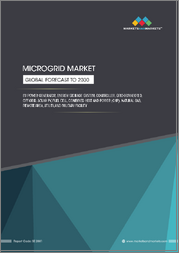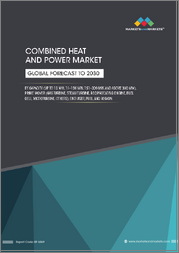
|
시장보고서
상품코드
1637756
유럽의 열병합발전 시장 - 점유율 분석, 산업 동향 및 통계, 성장 예측(2025-2030년)Europe Combined Heat and Power - Market Share Analysis, Industry Trends & Statistics, Growth Forecasts (2025 - 2030) |
||||||
유럽의 열병합발전 시장은 예측 기간 동안 CAGR 8% 이상을 기록할 전망입니다.

COVID-19 팬데믹은 2020년 시장에 심각한 영향을 미쳤습니다. 현재 시장은 전염병 이전 수준에 도달했습니다.
주요 하이라이트
- 중기적으로는 에너지 수요 증가, 에너지 비용 저감, 재생 가능 에너지 통합, 이산화탄소 배출량 감소 등이 연구 대상 시장의 성장을 이끌 것으로 예상됩니다.
- 한편, 계통연계와 다액의 초기설비투자는 예측기간 중 유럽의 열병합발전 시장의 성장을 방해할 것으로 예상됩니다.
- 이 지역에서는 소규모 제조 장비 개발에 대한 투자가 증가하고 있으며 예측 기간 동안 유럽의 열병합발전 시장에 유리한 성장 기회가 생길 가능성이 높습니다.
- 독일은 시장을 독점하고 있으며 예측 기간 동안 가장 높은 CAGR로 추이할 가능성이 높습니다. 이 성장은 일본의 투자 증가와 정부의 지원 시책 때문입니다.
유럽의 열병합발전 시장 동향
바이오매스 기반의 CHP가 시장에서 현저한 성장을 이룹니다.
- 최근 몇 년동안 바이오 매스 산업은 크게 성장했습니다. 바이오매스의 연소는 이산화탄소를 배출하지 않는 과정입니다. 바이오매스 열전병은 열과 전기에 대한 수요가 항상 있는 곳에 유용한 기술입니다.
- 2021년 유럽의 바이오에너지 생산량은 41,846MW였습니다. 그러나 이 수치는 2020-2021년에 376MW 증가했으며, 2021년 바이오에너지 생산량은 41,846MW로 최고조에 달했습니다.
- 중소규모의 CHP 플랜트는 일반적으로 현지에서 사용 가능한 바이오매스를 사용합니다. 대규모 CHP 플랜트나 석탄·바이오매스 혼소발전소에서는 광대한 지역에서 조달한 바이오매스나 수입목재·임업잔사가 필요합니다.
- 코제너레이션(열병합발전)은 현재 유럽 전력의 11%, 열의 15%를 공급하고 있으며, EU의 CO2 감축 목표의 21%, 에너지 효율 목표의 15%에 공헌하고 있습니다.
- 2030년까지 열병합 발전은 유럽 전력의 20%, 열의 25%를 공급하고 EU의 CO2 감축 목표의 23%, 에너지 효율 목표의 18%에 기여할 것으로 보입니다. 2050년까지 열병합 발전을 모든 열병합발전에 우선시하고 귀중한 에너지 낭비를 피함으로써 EU의 에너지 믹스에서 열병합 능력을 두 배로 늘릴 수 있을 것으로 보입니다.
- 몰타, 키프로스, 그리스에서는 5% 이하인 반면 덴마크, 핀란드, 라트비아, 리투아니아, 슬로바키아에서는 30%를 넘습니다. 전반적으로 유럽 수준에서 열병합 발전은 지난 몇 년동안 안정되어 있습니다.
- 유럽의 CHP 산업은 산업용으로, 펄프·제지, 알루미늄, 화학, 세라믹, 유리, 섬유, 식음료, 철강 제조업체 등의 섹터에 전력과 증기를 공급하고 있습니다.
시장을 독점하는 독일
- 유럽 최대의 경제대국인 독일은 CHP 전용법을 제정하고 2025년까지 120 TWh라는 목표를 내세워 CHP에 명확한 야심을 안고 있습니다. 이 나라는 CHP의 본격적인 성장을 경험하고 있습니다. 전력의 16%를 열병합 발전에서 얻었으며 유럽 평균의 11%를 크게 초과했습니다.
- 독일의 2021년 발전량은 584.5 테라와트 때로 전년보다 2% 가까이 증가했습니다. 2017년에는 1.9테라와트시 감소했고, 피크시에는 651테라와트시를 넘어섰습니다.
- 주목할만한 CHP 프로젝트가 유럽 전역에서 여러 가지를 이루고 있으며 건설 중이거나 승인되었습니다. 가장 큰 프로젝트 중 하나는 독일 함부르크의 북쪽 약 90km에 위치한 항구 도시 킬에서 진행중인 지자체 코제네레이션 프로젝트입니다.
- 독일은 대규모 지역 난방 네트워크에 대한 투자에 박차를 가하는 보증 보험료를 도입하여 지원 제도를 개선했습니다. 석유 정제 및 화학의 주요 산업은 적절한 열 부하를 가진 소규모 소매업에 이어졌습니다.
- 최근 몇 년동안 개인 주택을 위한 마이크로 CHP 유닛도 독일과 유럽 시장에 진출했습니다. 이 때문에 이 나라에서는 CHP를 추진하는 이니셔티브가 높아지고 있어 예측기간 중 CHP 시장 전체 수요를 견인할 것으로 예상됩니다.
유럽의 열병합발전 산업 개요
유럽의 열병합발전 시장은 적당히 세분화되어 있습니다. 이 시장의 주요 기업(순부동)으로는 2G Energy AG, General Electric Company, Siemens AG, Mitsubishi Hitachi Power Systems Europe Ltd, Engie SA 등이 있습니다.
기타 혜택
- 엑셀 형식 시장 예측(ME) 시트
- 3개월간의 애널리스트 서포트
목차
제1장 서론
- 조사 범위
- 시장의 정의
- 조사의 전제
제2장 조사 방법
제3장 주요 요약
제4장 시장 개요
- 소개
- 2027년까지 시장 규모와 수요 예측(단위: 10억 달러)
- 최근 동향과 개발
- 정부의 규제와 시책
- 시장 역학
- 성장 촉진요인
- 억제요인
- 공급망 분석
- Porter's Five Forces 분석
- 공급기업의 협상력
- 소비자의 협상력
- 신규 참가업체의 위협
- 대체품의 위협
- 경쟁도
제5장 시장 세분화 및 분석
- 용도
- 주택용
- 상업
- 산업용 및 유틸리티용
- 연료 유형
- 천연가스
- 재생 가능
- 바이오매스
- 석탄
- 기타 연료
- 지역
- 독일
- 영국
- 네덜란드
- 기타 유럽
제6장 경쟁 구도
- M&A, 합작사업, 제휴, 협정
- 주요 기업의 전략
- 기업 프로파일
- Engie SA
- General Electric Company
- Siemens AG
- Mitsubishi Hitachi Power Systems Europe Ltd
- UPM
- 2G Energy AG
- Wartsila
- Fleetsolve
- Vatenfall
제7장 시장 기회와 앞으로의 동향
JHS 25.02.06The Europe Combined Heat and Power Market is expected to register a CAGR of greater than 8% during the forecast period.

The COVID-19 pandemic affected the market severely in 2020. Presently, the market has reached pre-pandemic levels.
Key Highlights
- Over the medium term, the increasing energy demand, lowering energy costs, integration of renewable energy, and reducing carbon emissions are expected to drive the growth of the market studied.
- On the other hand, grid interconnection and significant initial capital investment are expected to hamper the growth of Europe's combined heat and power market during the forecast period.
- Nevertheless, increasing investment in the development of small-sized manufacturing units in the region will likely create lucrative growth opportunities for Europe's combined heat and power market during the forecast period.
- Germany dominates the market and is likely to witness the highest CAGR during the forecast period. This growth is attributed to the increasing investments and supportive government policies in the country.
Europe Combined Heat and Power Market Trends
Biomass-based CHP to Witness Significant Growth in the Market
- Over the past few years, the biomass industry has grown significantly. Biomass combustion is a carbon-free process, as the resulting CO2 is previously captured by the plants being combusted. Biomass combined heat and power can be a beneficial technology for sites with a constant demand for heat and electricity.
- Europe's bioenergy production amounted to 41,846 MW in 2021. However, figures increased by 376 MW of bioenergy between 2020 and 2021, peaking at 41,846 MW of bioenergy in 2021.
- Small- and medium-sized CHP plants are usually sourced with locally available biomass. Large CHP plants and coal/biomass co-firing power plants require biomass sourced from a vast region or imported wood and forestry residues.
- Cogeneration, or combined heat and power, currently provides 11% of Europe's electricity and 15% of its heat, contributing up to 21% of the EU's CO2 reduction target and 15% of the EU's energy efficiency target.
- By 2030, cogeneration will likely provide 20% of electricity and 25% of heat in Europe, contributing up to 23% of the EU's CO2 reduction target and 18% of the EU's energy efficiency target. By 2050, the sector is likely to double the cogeneration capacity in the EU energy mix by ensuring that cogeneration is prioritized for all thermally generated electricity and heat, thus avoiding wasting valuable energy.
- The contribution of CHP to the energy mix varies significantly among European countries, from less than 5% in Malta, Cyprus, and Greece, to more than 30% in Denmark, Finland, Latvia, Lithuania, and Slovakia. Overall, at the European level, cogeneration has remained stable during the past few years.
- Europe's CHP industry is in industrial applications, providing power and steam to sectors such as pulp and paper, aluminum, chemicals, ceramics, glass, textiles, food and drink, and steel manufacturers.
Germany to Dominate the Market
- Germany, Europe's largest economy, has set a clear ambition for CHP with a dedicated law and a target of 120 TWh by 2025. The country has experienced real CHP growth. It derives 16% of its electricity from cogeneration, well above the European average of 11%.
- Germany generated 584.5 terawatt hours of electricity in 2021, an increase of nearly 2% from the previous year. Nevertheless, in 2017, these figures decreased by 1.9 terawatt hours and peaked at over 651 terawatt hours.
- Several high-profile CHP projects have come up throughout Europe, are under construction, or have been approved. One of the largest projects is the municipal cogeneration project underway in the port city of Kiel, about 90 km north of Hamburg, Germany.
- Germany upgraded its support scheme, introducing guaranteed premiums that spurred investments in large district heating networks. Key industries in refining and chemicals followed smaller retail businesses with suitable heat loads.
- Micro-CHP units for individual homes have also entered the German and European markets in the past few years. Hence, a growing initiative to promote CHP in the country is expected to drive the demand for the overall CHP market over the forecast period.
Europe Combined Heat and Power Industry Overview
Europe's combined heat and power market is moderately fragmented in nature. Some of the major players in the market (in no particular order) include 2G Energy AG, General Electric Company, Siemens AG, Mitsubishi Hitachi Power Systems Europe Ltd, and Engie SA.
Additional Benefits:
- The market estimate (ME) sheet in Excel format
- 3 months of analyst support
TABLE OF CONTENTS
1 INTRODUCTION
- 1.1 Scope of the Study
- 1.2 Market Definition
- 1.3 Study Assumptions
2 RESEARCH METHODOLOGY
3 EXECUTIVE SUMMARY
4 MARKET OVERVIEW
- 4.1 Introduction
- 4.2 Market Size and Demand Forecast in USD billion, till 2027
- 4.3 Recent Trends and Developments
- 4.4 Government Policies and Regulations
- 4.5 Market Dynamics
- 4.5.1 Drivers
- 4.5.2 Restraints
- 4.6 Supply Chain Analysis
- 4.7 Porter's Five Forces Analysis
- 4.7.1 Bargaining Power of Suppliers
- 4.7.2 Bargaining Power of Consumers
- 4.7.3 Threat of New Entrants
- 4.7.4 Threat of Substitute Products and Services
- 4.7.5 Degree of Competition
5 MARKET SEGMENTATION AND ANALYSIS
- 5.1 Applicaton
- 5.1.1 Residential
- 5.1.2 Commercial
- 5.1.3 Industrial and Utility
- 5.2 Fuel Type
- 5.2.1 Natural Gas
- 5.2.2 Renewable
- 5.2.3 Biomass
- 5.2.4 Coal
- 5.2.5 Other Fuel Types
- 5.3 Geography
- 5.3.1 Germany
- 5.3.2 United Kingdom
- 5.3.3 Netherlands
- 5.3.4 Rest of Europe
6 COMPETITIVE LANDSCAPE
- 6.1 Mergers and Acquisitions, Joint Ventures, Collaborations, and Agreements
- 6.2 Strategies Adopted by Leading Players
- 6.3 Company Profiles
- 6.4 Engie SA
- 6.4.1 General Electric Company
- 6.4.2 Siemens AG
- 6.4.3 Mitsubishi Hitachi Power Systems Europe Ltd
- 6.4.4 UPM
- 6.4.5 2G Energy AG
- 6.4.6 Wartsila
- 6.4.7 Fleetsolve
- 6.4.8 Vatenfall




















